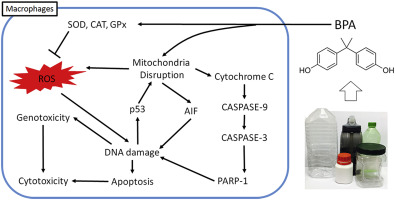Food and Chemical Toxicology ( IF 3.9 ) Pub Date : 2018-10-09 , DOI: 10.1016/j.fct.2018.09.078 Fu-Mei Huang , Yu-Chao Chang , Shiuan-Shinn Lee , Yung-Chyuan Ho , Ming-Ling Yang , Hui-Wen Lin , Yu-Hsiang Kuan

|
Bisphenol A (BPA) is primarily used in production of polycarbonate plastics and epoxy resins including plastic containers. BPA is an endocrine disruptor and supposes to induce asthma and cancer. However, so far only a few evidences have shown the BPA-induced toxic effect and its related mechanism in macrophages. BPA demonstrated cytotoxic effect on RAW264.7 macrophages in a concentration and time-dependent manner. BPA induces necrosis, apoptosis, and genotoxicity in a concentration-dependent manner. Phosphorylation of cytochrome C (cyto C) and p53 was due to mitochondrial disruption via BCL2 and BCL-XL downregulation and BAX, BID, and BAD upregulation. Both caspase-dependent, including caspase-9, caspase-3, and PARP-1 cleavage, and caspase-independent, such as nuclear translocation of AIF, pathways were activated by BPA. Furthermore, generation of reactive oxygen species (ROS) and reduction of antioxidative enzyme activities were induced by BPA. Parallel trends were observed in the effect of BPA on cytotoxicity, apoptosis, genotoxicity, p53 phosphorylation, BCL2 family expression exchange, caspase-dependent and independent apoptotic pathways, and ROS generation in RAW264.7 macrophages. Finally, BPA-exhibited cytotoxicity, apoptosis, and genotoxicity could be inhibited by N-acetylcysteine. These results indicated that the toxic effect of BPA was functioning via oxidative stress-associated mitochondrial apoptotic pathway in macrophages.
中文翻译:

双酚 A 通过小鼠巨噬细胞中氧化应激相关的线粒体凋亡途径表现出细胞毒性或基因毒性潜力
双酚 A (BPA) 主要用于生产聚碳酸酯塑料和环氧树脂,包括塑料容器。 BPA 是一种内分泌干扰物,可能会诱发哮喘和癌症。然而,迄今为止只有少数证据表明BPA对巨噬细胞的毒性作用及其相关机制。 BPA 对 RAW264.7 巨噬细胞具有浓度和时间依赖性的细胞毒性作用。 BPA 以浓度依赖性方式诱导坏死、细胞凋亡和遗传毒性。细胞色素 C (cyto C) 和 p53 的磷酸化是由于 BCL2 和 BCL- XL下调以及 BAX、BID 和 BAD 上调导致线粒体破坏所致。 BPA 激活了 caspase 依赖性通路(包括 caspase-9、caspase-3 和 PARP-1 裂解)和 caspase 非依赖性通路(例如 AIF 核转位)。此外,BPA 还会诱导活性氧 (ROS) 的产生和抗氧化酶活性的降低。在 RAW264.7 巨噬细胞中,BPA 对细胞毒性、细胞凋亡、基因毒性、p53 磷酸化、BCL2 家族表达交换、caspase 依赖性和独立细胞凋亡途径以及 ROS 生成的影响观察到平行趋势。最后,N-乙酰半胱氨酸可以抑制 BPA 表现出的细胞毒性、细胞凋亡和基因毒性。这些结果表明BPA的毒性作用是通过巨噬细胞中氧化应激相关的线粒体凋亡途径发挥作用的。











































 京公网安备 11010802027423号
京公网安备 11010802027423号